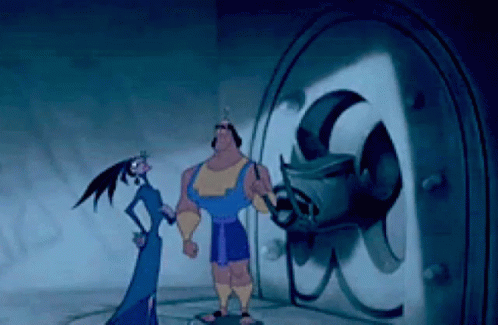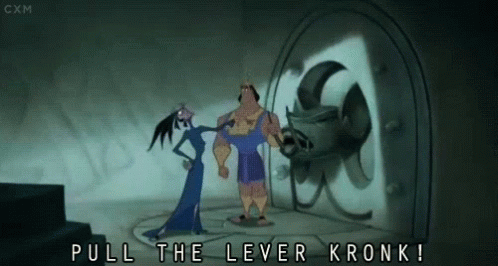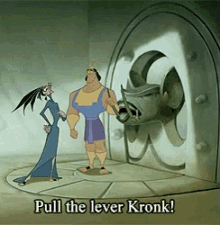Pull The Lever Kronk - Understanding Action And Influence
The phrase "pull the lever Kronk" has, in a way, become a very well-known saying, popping up in conversations and on the internet. It brings to mind a moment of big decision, often with a touch of humor, and sometimes, too it's almost, a bit of worry about what might happen next. This simple instruction, spoken with a certain urgency, really makes us think about the immediate action required and the results that come from it.
But what does it truly mean to "pull" something? Beyond the funny cartoon scene, the act of pulling is quite fundamental to how we interact with the world. It’s about putting forth effort, making something move, or maybe even drawing something closer to us. It can be a very direct physical act, or, in some respects, a more subtle kind of influence that guides things along.
We often find ourselves in situations where a "pull" is needed, whether it's opening a stubborn door or making a significant choice. The idea of "pulling the lever Kronk" helps us consider the various ways we apply our will to make things happen, and what happens when we do. This piece will look at the different meanings of "pull" and how they connect to those moments when a decision, or an action, just has to be made.
Table of Contents
- What Does it Mean to Pull Something?
- The Force Behind Pulling- What's Going On?
- How Does Influence Play a Part in Pulling?
- What Happens When You Pull Too Hard?
- Direction and Purpose When You Pull
- The Connection Between Pull and Attraction
- Pulling in a Digital Space
- The Many Faces of Pulling
What Does it Mean to Pull Something?
When we talk about "pulling," we're really getting at the idea of putting effort into something to make it move closer to us. It's like when you have a heavy box and you lean back, using your strength to get it to slide across the floor. This action is about creating movement in a particular path, bringing the item nearer to where you are, or, perhaps, just getting it to shift from its resting spot. You hold onto it with a good grip and then use your physical might to get it going. It’s pretty straightforward, actually, in a way, just a simple push and pull.
Sometimes, this movement needs quite a bit of physical effort. Think about trying to open a window that's stuck. You might have to really put your back into it, trying to get it to budge. The whole point is to cause or try to cause that object to move in the path of your effort. This is how we generally picture "pulling" – a direct application of strength to get something to come along with us or to change its place. It's a fundamental action we learn very early on, something we do without much thought.
The Simple Act of Pulling the Lever Kronk
When someone says "pull the lever Kronk," they are, of course, asking for a very specific physical action. It's about reaching out, taking hold of that handle, and then drawing it down or towards you. This is the most basic sense of "pull" in play. It implies a clear, singular movement with an immediate outcome. The instruction itself is quite direct, leaving little room for confusion about what needs doing. It’s a call to action, pure and simple, and that is what makes it so memorable.
The phrase, too it's almost, suggests a moment where a simple physical act has significant consequences. You grab the lever, you move it, and something happens. This could be anything from opening a secret passage to, perhaps, setting off a chain of events. The very act of taking hold and moving that lever is the core of what "pull" means in this situation. It's about causing a change by applying a bit of effort in a very particular way, quite literally changing the position of something.
The Force Behind Pulling- What's Going On?
Every time we "pull" something, there's a certain amount of strength or energy being used. It’s not just a wish; it’s an active application of power. This strength makes things move. For instance, if you're trying to open that stubborn window, you're putting a lot of force into it, hoping to overcome whatever is holding it shut. The harder you pull, the more likely it is to move. This kind of effort is about getting an object to respond to your command, to shift from where it is to where you want it to be. It's a direct connection between your effort and the object's movement.
This idea of applying strength also extends to things that aren't physical. Sometimes, a situation might "pull" you in a certain direction, meaning it has a strong influence that makes you want to go that way. Or a person might have a "pull" over you, meaning their charm or their ideas have a way of drawing you in. So, the concept of "force" behind pulling isn't just about muscles; it can be about a strong attraction or a guiding effect that leads you toward something. It’s quite interesting, how that works, you know, the invisible forces at play.
More Than Just Moving - Pull the Lever Kronk's Hidden Power
When we hear "pull the lever Kronk," we're not just thinking about the physical motion of the hand on the lever. There's a lot more going on, typically. This phrase implies a hidden power, a cause-and-effect relationship where a simple action sets off bigger events. The strength behind the "pull" isn't just about moving a piece of metal; it's about activating a system, starting a process, or making a decision that has significant ripple effects. It's the moment where potential becomes reality.
The "power" in "pull the lever Kronk" is in the consequences of the action. It's the strength of the choice being made. The lever itself might not be heavy, but the outcome of its movement is often quite weighty. This shows that "pulling" can be a very simple action with very big results, sometimes even life-altering ones. It's the trigger for something much larger, a small physical act with a much larger, sometimes unseen, impact. This makes the phrase, as a matter of fact, very powerful in its own right.
How Does Influence Play a Part in Pulling?
The idea of "pull" isn't always about using your muscles. Sometimes, it's about a kind of attraction or a way someone can guide others. Think about a popular leader whose ideas draw people in; that's a kind of "pull." It’s an invisible force that makes people want to move in a certain path or agree with a certain idea. This type of pull is about persuasion, charm, or the sheer strength of an idea that makes others want to follow along. It’s a very subtle kind of movement, a gentle coaxing rather than a direct tug.
This influence can be quite strong, making you feel drawn to a particular person, a new hobby, or even a specific way of thinking. It's not about being forced, but rather about feeling a natural inclination to move in a certain path. This shows that "pull" has many faces, not just the physical one. It can be a quiet suggestion that shapes choices, or a powerful idea that gathers many people behind it. It’s quite fascinating, how that works, isn't it, the way minds can be swayed.
When Others Pull the Lever Kronk for You
In the context of "pull the lever Kronk," influence often comes into play when someone else is giving the instruction. Kronk isn't making the decision on his own; he's being told what to do. This means someone else's will is "pulling" him towards a specific action. This is a very clear example of influence at work, where one person's command causes another to act. It highlights how decisions can be made by one person, but the physical act of "pulling" is carried out by another.
This kind of situation, too it's almost, makes us think about responsibility and who is truly in charge. Even if Kronk is the one physically moving the lever, the real "pull" comes from the person giving the orders. It’s a reminder that sometimes, our actions are a direct result of someone else's guiding hand, or their strong desire for a certain outcome. This shows how "pull" can be a chain of command, where one person's influence causes another to perform the necessary action, making them, in a way, a tool for a larger plan.
What Happens When You Pull Too Hard?
Sometimes, when we put too much effort into pulling, we can cause problems. If you try to open that stuck window with all your might, you might end up breaking something or, perhaps, hurting yourself. The text mentions injuring a muscle by stretching it too much, which is a very real consequence of over-pulling. It's a reminder that applying strength needs to be done with some care and thought. Just because you can exert a lot of effort doesn't mean you always should, or that it will always lead to the best outcome.
This applies to non-physical "pulls" as well. If you try to "pull" someone too hard into your way of thinking, you might push them away instead. Or if you try to "pull" a situation too quickly in a certain path, you might cause unintended problems. There's a balance to finding the right amount of effort, the right amount of influence, so that you achieve your goal without causing harm. It’s a pretty important lesson, actually, about moderation and understanding limits.
Avoiding Injury When You Pull the Lever Kronk
While "pull the lever Kronk" is often about a specific, perhaps urgent, action, the idea of "pulling too hard" can still apply. What if the lever is stuck? Or what if the consequences of pulling it are so drastic that the "pull" itself feels like an injury to the system? In a figurative sense, pulling the lever without considering the full impact could lead to a "muscle strain" for a project or a relationship. It's about the potential for damage when an action is taken without enough thought or preparation.
So, even in a simple command like "pull the lever Kronk," there's an unspoken need for a certain kind of carefulness. You want to make sure the action is done correctly, without breaking anything, or, perhaps, causing more problems than it solves. It’s a lesson that even straightforward actions can have unexpected negative outcomes if not approached with a bit of foresight. You know, sometimes, the simplest things can cause the biggest headaches if not handled just right.
Direction and Purpose When You Pull
A key part of pulling is that it usually has a clear direction and a goal. You don't just pull aimlessly. When you pull a door, you want it to open or close. When you pull a rope, you want to move whatever is attached to it. The act of pulling is always directed towards a certain result, a specific position, or a particular path. It's about moving something from one spot to another, or getting it to operate in a certain way. This purpose gives meaning to the effort you put in.
This idea of purpose is what makes "pull" such an active word. It's not just about applying force; it's about applying force with a reason. Whether you're trying to move something toward yourself, or simply trying to get it to shift, there's always a reason behind the action. This helps us understand that every "pull" is a step towards achieving something, a way of shaping the world around us to fit our needs or desires. It’s really about making things happen, with a very clear idea of where they should end up.
Aiming True - Why You Pull the Lever Kronk
The command "pull the lever Kronk" is, of course, given with a very specific purpose in mind. The person giving the order wants a particular outcome. The lever isn't being pulled just for the sake of it; it's being pulled to achieve something. This could be to activate a machine, to open a door, or to change a course of events. The "pull" here is directly linked to a desired result, making it a very intentional action. It's about making sure the action serves a larger plan.
So, when we consider "pull the lever Kronk," we're thinking about the aim behind the action. What is the goal? What is supposed to happen once that lever is moved? This makes the "pull" a purposeful act, a step taken to bring about a specific change. It highlights that every action, even a simple one, usually has a reason behind it, a desired end point. It’s quite simple, really, a means to an end, a very direct path to a goal.
The Connection Between Pull and Attraction
Beyond physical movement, "pull" can also mean a kind of attraction or influence. Something might "pull" you in because it's interesting, appealing, or simply because it has a strong presence. This isn't about physical effort; it's about a drawing power, something that makes you want to get closer or pay attention. It could be a new idea that catches your interest, a person with a captivating personality, or a place that just feels right. This kind of pull is often very subtle, but very powerful.
This magnetic quality can be quite compelling, guiding our choices and our focus without us even realizing it sometimes. It's the feeling of being drawn to something, a quiet force that shapes our desires and our path. This shows that "pull" isn't always about making things move with your hands; it can be about something that moves your mind or your heart. It’s a pretty interesting way to think about how things influence us, isn't it, the unseen forces that draw us in.
The Allure to Pull the Lever Kronk
While the command "pull the lever Kronk" is usually an instruction, there can be a certain "allure" to the act itself, especially in stories. The mystery of what the lever does, the excitement of the unknown outcome, can create a kind of pull for the character, or for us watching. It's the attraction of the big reveal, the desire to see what happens next. This isn't a physical pull, but a mental or emotional one, drawing us towards the moment of action.
Even if it's someone else's command, the very idea of "pulling the lever Kronk" holds a certain dramatic appeal. It's the moment of truth, the point of no return. This makes the "pull" not just about the physical act, but about the compelling nature of the situation itself, drawing everyone's attention to that one pivotal moment. It’s pretty captivating, how a simple instruction can hold so much dramatic weight, truly making you want to see it happen.
Pulling in a Digital Space
The idea of "pull" also exists in the world of computers and software. For example, when people work on computer projects together, they often use tools that let them "pull" changes from a central place. This means getting the newest versions of files or code to their own computer. It's like reaching out and drawing the most up-to-date information to yourself, making sure everyone is working with the same material. This digital "pull" is about getting information to move in a specific direction, from a shared source to your personal workspace.
This is a very common action in programming, where you might "fetch," "pull," "push," and "sync" to keep your project files organized. When you "pull," you are essentially taking hold of new updates and bringing them into your own project. It’s a way of making sure your work stays current with what everyone else is doing. So, the concept of "pulling" extends far beyond physical objects, showing up in the very way we manage information and work together in the digital world. It’s quite a useful concept, actually, for keeping things in order.
Version Control and How You Pull the Lever Kronk
In the digital world, "pulling the lever Kronk" might mean making a specific command to get the latest updates for a project. It’s a very deliberate action, just like moving a physical lever, but it happens with lines of code. When you "pull" in this context, you are initiating a process that brings new data or changes into your work area. This "lever" is a command, and "pulling" it means executing that command to update your project.
This digital "pull" has very clear consequences, just like a physical lever. Once you "pull" the updates, your project changes. It’s a way of making sure everyone is on the same page, bringing the collective work together. So, the idea of "pull the lever Kronk" can, in a way, be seen in the precise and impactful actions we take in software development, where a simple command can have wide-ranging effects on a project's status. It’s a pretty good parallel, actually, for understanding how actions in the digital world work.
The Many Faces of Pulling
As we've seen, the word "pull" has many different meanings, far more than just a simple physical act. It can
- Stray Dog Lighting
- Fallen Angels Clothing
- Bea Decor
- French Prairie Gardens Oregon
- Plus Size Influencer

Kuzko Kronk Izma Alza La Leva Kronk Leva L'Altra Leva Le Follie Dell

Pull The Lever Kronk Wrong Lever GIFs | Tenor

Pull The Lever Kronk GIFs | Tenor